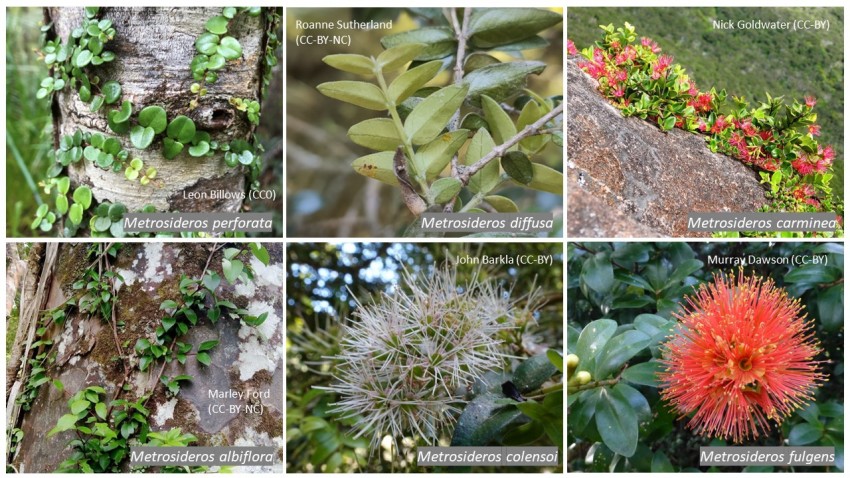Rātā vines: beautiful and vulnerable
Our Metrosideros vines occur on the North Island, South Island and some surrounding islands, like Three Kings. Most have white flowers, although M. carminea has carmine flowers and M. fulgens has orange-red or sometimes yellow flowers. Some, like M. perforata and M. colensoi have been cultivated and are available from specialist nurseries while others are more difficult to propagate (M. albiflora). The timing of flowering varies by species, with M. diffusa flowering in the late spring/summer and M. fulgens flowering in the autumn/winter.

New Zealand's Metrosideros vines
When myrtle rust arrived in New Zealand, all species in the Myrtaceae were given the status of Threatened – Nationally Vulnerable out of an abundance of caution. Since then, myrtle rust has been detected on five of our vines: M. carminea, M. fulgens, M. perforata, M. colensoi and M. diffusa. The disease has not yet been detected on M. albiflora.
Two Beyond Myrtle Rust master’s students, Hone Ropata (Plant & Food) and Ngaio Balfour (Scion), are delivering new insights into the susceptibility of Aotearoa’s Metrosideros vines. For part of Hone’s research, he is artificially inoculating M. carminea, M. fulgens and M. perforata with Austropuccinia psidii, the pathogen that causes myrtle rust. So far, M. carminea and M. fulgens have developed symptoms.
“These vines exhibited similarly high infection levels to the levels we find on species already known to be highly susceptible like Lophomyrtus bullata or some of the Syzygium species,” says Hone.
While M. perforata did not become infected after inoculation, Hone is doubtful that this is because the plant is less susceptible.
“We got these plants from a nursery that had sprayed them with fungicide,” says Hone. “I expect that they would have expressed symptoms if they hadn’t been treated, but I can’t say for sure.”
Ngaio also inoculated M. perforata as a Scion summer student and found that the species was susceptible to myrtle rust under her experimental conditions. However, her observations in the field have made her wonder if this species is indeed less susceptible than other vines.
“I haven’t found infections on M. perforata in the field,” says Ngaio. “And to the best of my knowledge, infection has only been observed twice in the field by others.”
For part of her Master’s, Ngaio has measured infection levels of M. diffusa and M. fulgens in the field.
“M. diffusa and M. fulgens do become infected, and I’ve seen dieback on one individual M. diffusa, which shows it can get very heavily infected in the field.”
There is still much to be learned about our endemic Metrosideros vines, and we look forward to more results from Hone and Ngaio. If you see myrtle rust on any of our Metrosideros vines, in your town or while out in the ngahere, please post an observation on iNaturalist NZ – Mātaki Taiao.
Foundational information on our vines was gathered from the NZ Myrtaceae Key, assembled by Murray Dawson, Matt Buys, Chris Ecroyd, Elizabeth Miller, Colin Ogle, and Peter de Lange and funded by the Ministry for Primary Industries (MPI) Biosecurity New Zealand (2019/20).
